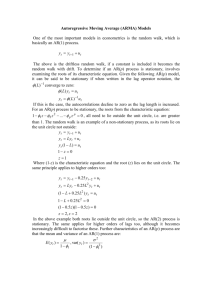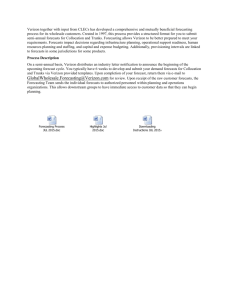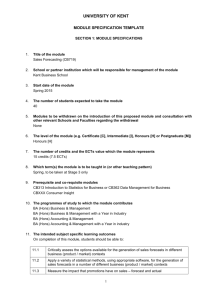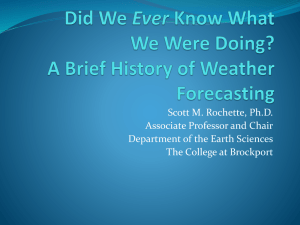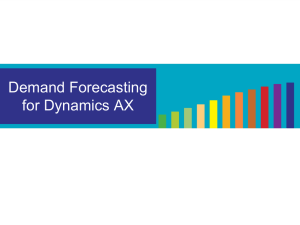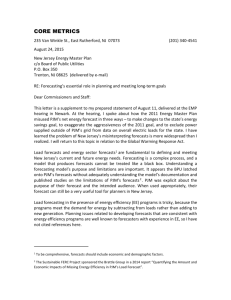Amtrak Demand Forecasting Overview
advertisement
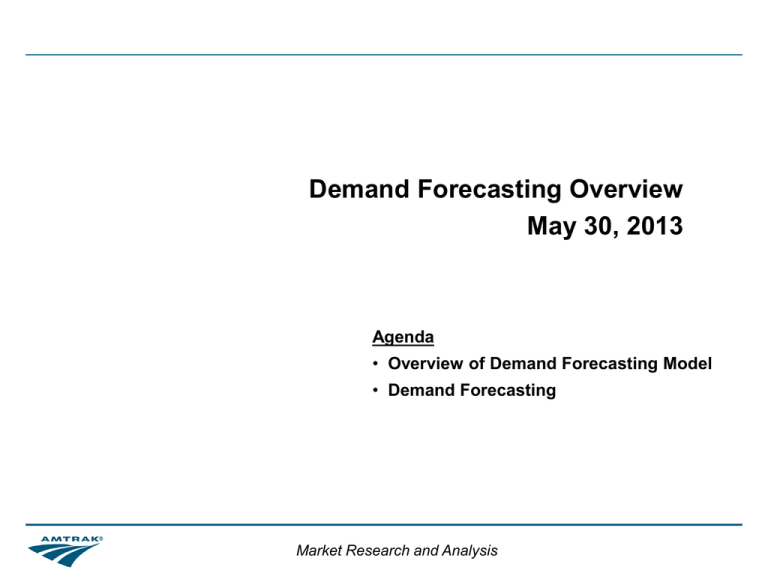
Demand Forecasting Overview May 30, 2013 Agenda • Overview of Demand Forecasting Model • Demand Forecasting Market Research and Analysis Overview of Demand Forecasting Model • Demand forecasts are developed using models created and maintained for Amtrak by AECOM • Separate models have been developed for the: – Northeast Corridor – Long Distance routes – State Corridor routes • These models are used to forecast both: – The expected demand for the current service (FY14 forecast as an example) – The impact of a proposed change of service • Proposed changes of service include: – Adding a station – Adding a frequency – Change in travel time – Change in schedule – Service change (WiFi as an example) Market Research and Analysis 2 Composition of the Models • The demand forecast models are based on extensive market research and other travel market data and inputs • Market research provides insight on both Amtrak customers’ and travel consumers’ sensitivity to: – Departure and arrival time – Travel time – On-time Performance (OTP) – Price – Frequency • Travel market data and inputs include: – Amtrak ridership and ticket revenue data – Amtrak timetables and pricing – FAA air passenger data – Airline schedules and fares – Socio-economic data and forecasts (provided by Moody’s Economy.com) – Highway network data providing competing auto travel times Market Research and Analysis 3 Composition of the Models (continued) • Key independent variables that drive the model forecasts include: – Travel time – Frequency – Departure/arrival time-of-day slots – Average rail fares – OTP – Travel time and cost of competing modes of travel – Population, employment, and income of each market served Market Research and Analysis 4 How Forecasts are Developed • The NEC and State Corridor models apply a two-stage approach: – First, the total travel market size (all modes) is forecasted – Then the total demand is divided by mode • Forecasts are built on the actual demand for each market over the last 12 months • Forecast are done at the market/city-pair level; the value for each of the independent variables listed below is determined for each market/city-pair – Travel time – Frequency – Departure/arrival time-of-day slots – Average rail fares – OTP – Travel time and cost of competing modes of travel – Population, employment, and income of each market served Market Research and Analysis 5 Examples of Recent Types of Demand Forecasts • FY14 demand – Ridership, ticket revenue and passenger miles were provided at the route/month level for FY14 – These can be provided at the city-pair level on request • Adding new stations – We will calculate the incremental demand from a proposed station addition – Both incremental demand and demand transferring from current stations are considered and reported – The expected impact from the additional trip time is also included • Change in travel time • Changes in frequency • Change in OTP • Changes in schedule Market Research and Analysis 6 FY15 Demand Forecast Schedule • We will develop the initial forecast for FY15 at the route and month level in September 2013 • We will update the FY15 forecast in January 2014 • This revised forecast will be made available for FY15 negotiations in early February 2014 Market Research and Analysis 7 How Amtrak Market Research & Analysis Team Works with State Partners 1. Demand Forecasting – We provide detailed forecasts for current and upcoming fiscal years – We can forecast the expected changes in demand for proposed changes in service – We can deliver more detailed forecasts and reports at cost 2. Market Research – We provide ridership profiles for all state corridor routes. We are updating these this summer. They include the following for our customers: Demographic: Who they are Behavioral: What they do Attitudinal: What they want – We manage specific market research projects at cost. Projects include: Pre-campaign exploratory research Post-campaign measurement (ROI) Passenger and travel consumer segmentation On-board ridership profiles and attitudinal studies Qualitative research on service offering (current and proposed) 3. Reporting Market Research and Analysis 8





